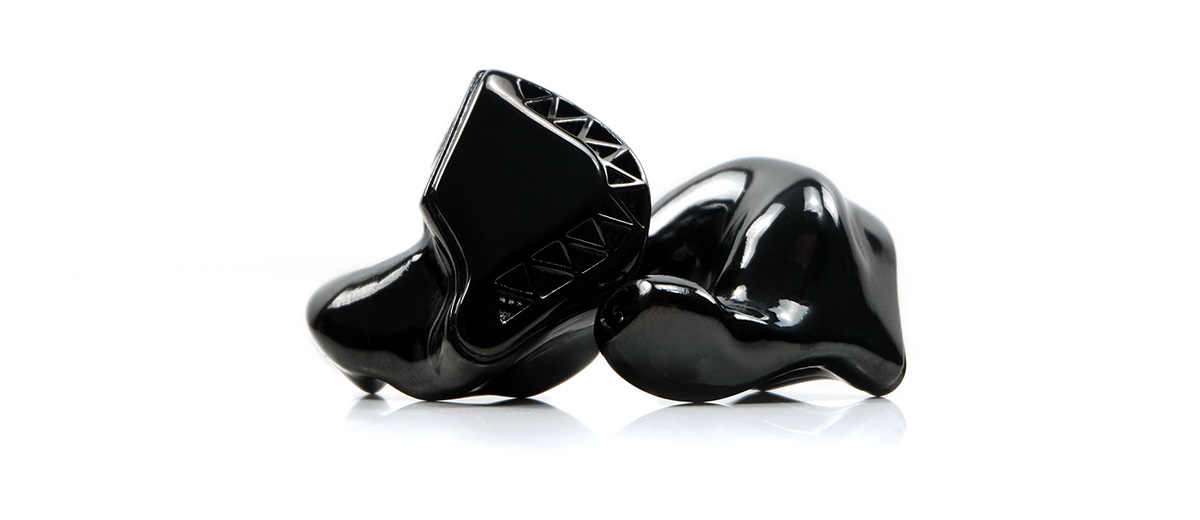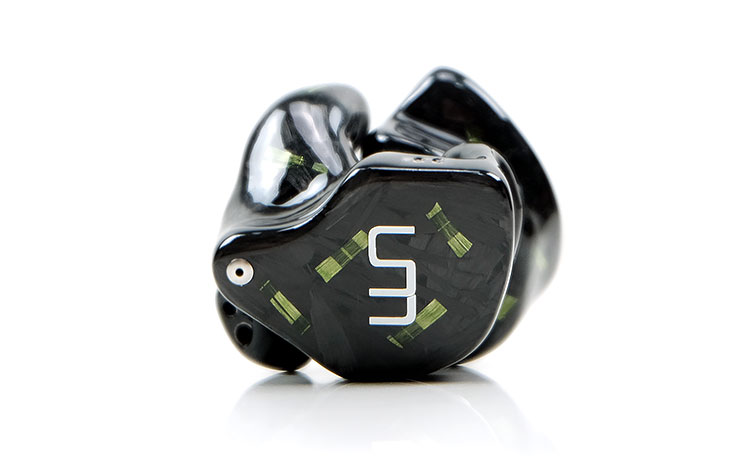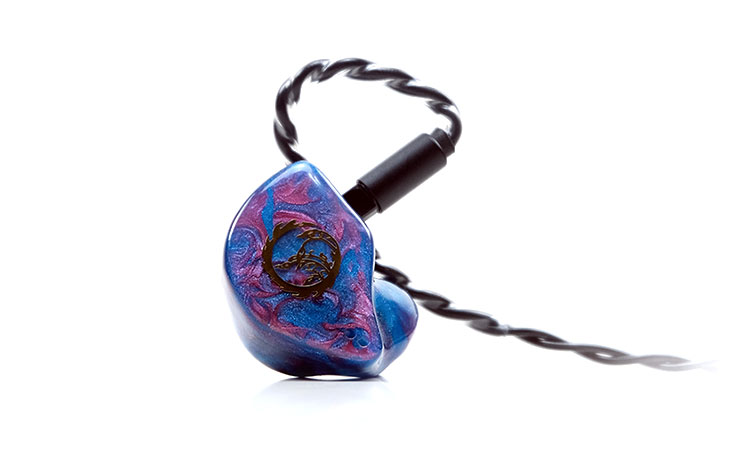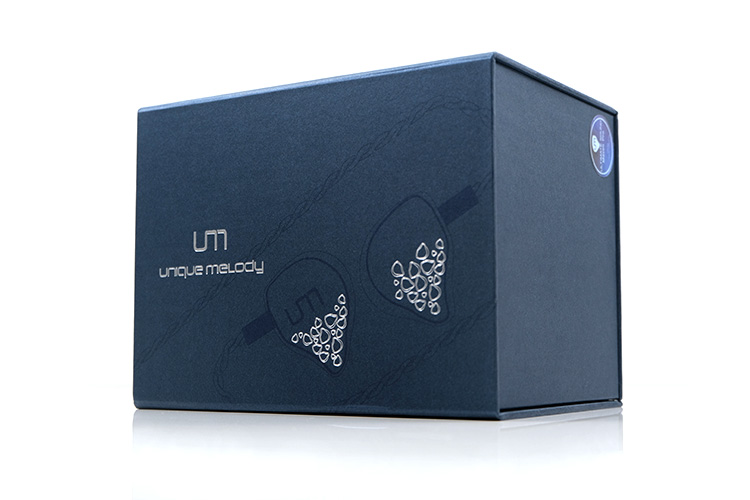Select Comparisons
Unique Melody Mason V3+
$3199
The Mason V3+ was the company’s c0-flagship monitor at the time of launch in mid-2020, alongside the Mentor V3+. You can find our full review of the Mason V3+ here.
Technical
Both of these custom monitors are packed to the gills with drivers More so with the Mason V3+ at 16 drivers though all of them are BA whereas the Maven Pro is a hybrid mix of BA and a dual electrostatic driver combo for the ultra-highs.
The driver grouping and internal acoustical design differ with the Mason V3+ offering an even split of 4 drivers for the lows, 4 for the lower mids, 4 for the upper mids, and 4 for the highs.
The Maven Pro reduces the midrange BA pack to two drivers and uses a single set of 4 woofer drivers for the lows rather than a 4/4 split for the lows and lower mids to get that 10 BA configuration.
Both monitors use a 4-way crossover though the bore count is 4 on the Maven Pro as opposed to five on the Mason V3+. Acoustically, the internals of the Maven Pro has been upgraded with their new tuning tunnel steel tube implementation drawn from the Mentor V3+.
Whereas with the Mason V3+, the adjustable DB-GO tuning module, (bass resistor), was the bigger pitch though it did use a heady mix of titanium-gold for its tubing and silver alloy internal wiring.
The Mason V3+ is rated at 19.6Ω and 107dB SPL compared to 30Ω and 112dB so neither are inefficient designs. However, in real-world testing, the Maven Pro is significantly more dynamic sounding and slightly louder also at matching volume levels.
Design
Both are custom monitors so the aesthetic is up to you and what you want rather than fixed in stone. For the universal version, it is arguable that the intricacies of the Maven Pro are much more labor-intensive and complex looking than the Mason V3+ version.
However, one common thread runs through both designs and that is UM’s quest for shell durability beyond regular shell materials. With the Mason V3+, we got the Dreamweaver fiber shells enhanced with a lightweight carbon fiber material.
The Maven Pro ups the ante even further with some very robust 3D machined titanium shells with a PVD finish which I am pretty sure is going to be a stronger design than the Mason V3+ Dreamweaver shells.
The dimensions are roughly the same for both customs. The two monitors use a long nozzle approach with outstanding passive isolation capability. Design-wise, I would say the Mason V3+ shells offer a bit more room for individual designs since the Maven Pro’s build approach is limited to just 3 monotone colors.
However, the Maven Pro custom lattice grid is a nice and unique motif though I think the more intricate universal version is exquisite looking. One thing to note, because the Maven Pro is made of titanium it can be initially colder in the ear in cooler temperatures but warms up pretty quickly.
The final note is the cable choice. The unique dual-tone 8-core of the Mason V3+ was never replicated beyond it and the Mentor V3+ with Hansound taking over construction duties on future models.
I think the M2 on the Maven Pro looks more modern but there is no denying the ability to switch between copper and silver (4-core each) on the Mason V3+ was a very interesting approach.
Performance
You actually get two performances from the Mason V3+, not one due to the cable switching capability. However, I tend to ignore the copper version as it’s too relaxed and soft sounding. The silver side of the cable is a cleaner pairing so the comparison will be based on that setup using the HiBy RS8 as the main source.
Ironically, both are really aiming for that warmish forgiving tone, you are just trading resolution for dynamics, and imaging complexity for timbral density. Both are impressive in their own way but will not appeal to the same user.
The Maven Pro is the more dynamic and bass-heavy performer with a stronger or more intimate vocal imaging experience. It pulls deep and relatively tall but where it comes second to the Mason V3+ is in the level of resolution and sense of space to allow detail to shine through.
This is where the Mason V3+ has an edge just in the level of technical refinement in terms of instrumental imaging. It offers a delicate but complex layering of those instruments within the acoustical space provided.
Some of that perceived space comes from a more relaxed 1-3k region which tends to leave me wanting in terms of vocal dynamics. A subdued low-end that lacks a bit of punch and a weaker fundamental doubles down on the softer midrange dynamics from the Mason V3+, something which the Maven Pro does a lot better in delivering.
If you want your monitor to sound beefy, and full-bodied with vocals to the fore then the Maven Pro is going to be the right choice here. It adds a stronger musical element and is better suited to modern rock and pop.
However, if you want a more complex imaging experience, one that pushes a little wider and teases out more detail then the Mason V3+ is the better solution.
Unique Melody MEST MKII
$1799
The MEST MKII was launched in the middle of 2021 and was rightly regarded as a high-performing monitor with a competitive price point for what was tucked inside. You can find our full review of the MEST MKII here.
Technical
The MEST MKII is still probably one of the most complex custom monitors in the market today at this price point. Its driver count is 7+1 with a hybrid configuration of a single DD for the lows, a dual BA driver unit for the mids and upper mids, dual BA for the highs, and dual Sonion electrostatic drivers for the ultra-highs.
The plus one is the dBC-s dual-sided Bone Conduction System which adds an additional layer from around the upper bass to the upper treble and is not part of any specific driver grouping.
The Maven Pro thus can be considered a simpler configuration with no dynamic driver though with a higher driver count overall at 4 for the lows, 2 for the mids, and 4 for the highs. It also has a dual EST driver design for the ultra-highs and a 4-way crossover as opposed to a 5-way inside the MEST MKII.
Less attention is made to the precise acoustical space inside the MEST MKII compared to the tuning tunnel metal tubes inside the Maven Pro. However, venting and airflow are important given that MEST MKII uses a dynamic driver so you will see what UM calls a tuning vent or small ‘metal hat’ on the face plate for airflow regulation.
The MEST MKII is rated at 12.3Ω and 112dB SPL which is slightly less resistive than the 30Ω and 112dB of the Maven Pro. However, in our real-world testing with a HiBy RS8, I did not find much difference between the two, given their matching SPL levels.
Design
Similar to the Mason V3+, the MEST MKII also uses a Dreamweaver fiber shell enhanced with a lightweight carbon fiber material. It is not as durable or as dense as the titanium alloy metals used inside the Maven Pro custom version but it is lighter with the difference felt in the ear.
Since they are both custom designs, the final aesthetic might differ depending on the colors and designs you choose, though volumetrically I find them to be quite similar and the fit to be very precise.
The MEST MKII follows a similar path to the Mason V3+ so you get a variety of carbon fiber and flake designs, this one being a green version. The Maven Pro is a bit more restrictive with the 3 color choices but the emphasis is more on that titanium build quality.
The Maven Pro has an edge for me in isolation with the additional venting on the MEST MKII allowing a bit more background noise to be heard from the aircon and similar rumbling appliances.
Cables are also the exact same with both using the 24AWG OCC copper 4-wire UM Copper M2 as their stock choice. It is a nice modern design with good dynamics, low resistance, and microphonics. Handles well also so the experience should be quite similar on both monitors.
Performance
If you are studying the FR charts for should catch on quite quickly as to what the key differences are between the two, namely the low-end tuning and how it affects the timbre beyond the bass.
This is a dual between the MEST MKII’s dynamic driver and the Maven Pro’s quad woofer BA design. The Maven Pro is more elevated in amplitude right across the sub-bass up to the lower mids and by quite some distance. It is immediately noticeable.
The MEST MKII is stronger right at the lowest marker, around 20-30Hz which is what I would expect from a dynamic driver. However, UM has scooped the curve around 200Hz which forces the driver to drop amplitude in a slow manner to that point with a gentle rise thereafter to the mids.
That results in less warmth and thickness in the MEST MKII mids timbre, less bass forwardness also combined with a dynamic driver level of decay which is slower but slightly firmer. The Maven Pro low-end is more pronounced, especially around 100Hz-20oHz with a stronger mid-bass punch. It also has a faster attack and shorter decay.
The knock-on effect is a slightly cleaner midrange tone from the MEST MKII versus a fuller denser timbre and a weightier fundamental from the Maven Pro in the same region. This is helped by some enhanced lower treble energy from the MEST MKII around the 4-5k region that in turn helps to create some additional crispness to percussion timbre.
Vocals sound more forward as well as being denser and smoother on the Maven Pro. It has a natural more forgiving tone whereas the MEST MKII might just reveal a bit more natural sibilance with its slightly leaner vocal performance.
Unique Melody MEXT
$1399
The MEXT was released in early 2022 with most describing it as a slightly stripped-down version of the MEST MKII with a cheaper price also. You can find our full review of the MEXT here.
Technical
Like the Maven Pro, the MEXT is a hybrid custom, (and universal) monitor though unlike the Maven Pro it uses a mix of dynamic and BA with no EST as opposed to BA and EST.
The precise grouping is a single 10mm dynamic driver for the lows and four balanced armature drivers with 2 for the mids and 2 for the highs using a 4-way crossover.
The Maven Pro also uses a 4-way crossover but uses a more expansive BA selection with 4 for the lows, 2 for the mids, and 4 for the highs. It also has those 2 EST drivers for the ultra-highs.
The MEXT also uses bone conduction though it differs from the MEST MKII version with an OBC or ‘Original Bone Conduction’ driver. This is a high-purity copper coil surrounded by a very strong N52 neodymium magnet and a vibrating steel sheet. I suspect the frequency range is more to the lows than the highs but that is undisclosed by UM.
The MEXT is rated at 16Ω and 108dB SPL so quite easy to drive though a little less sensitive than the Maven Pro which is rated at 112dB SPL. In our real-world testing with the Cayin N8ii in P+ mode, the Maven Pro did indeed sound slightly more dynamic and louder but not by a huge amount.
Design
I do like the bold and beautiful aesthetics of the MEXT sample we have here. It is much more striking than the monotone black of the Maven Pro version we have here.
Mind you, I believe the version of the MEST we have is a regular shell material and nowhere near as robust or as exotic as the 3D titanium metal alloy used in the Maven Pro. You can feel the difference between them right away in your hand and in the ear with the Maven Pro feeling a lot denser and heavier.
I have done a drop test on the MEXT from 1m on a hard surface, albeit not voluntarily and it did survive so I would not be too fearful of any overt fragility in the MEXT shell.
Although both match each other in fitting since they are customs the Maven Pro does isolate a lot better. The lack of venting on the all-BA design on the Maven Pro plus the denser metal build blocks out a lot more noise than the regular acrylic shell.
Cables are slightly different also. Both are Hansound creations and they do look very similar aesthetically with matching black jackets and barrel designs. However, the version used with the MEXT is the M1 which is a grade down from the M2 using a 26AWG gauge OFHC copper 4-wire geometry as opposed to the larger 24AWG OFC copper inside the M2.
Performance
The MEXT is like a mix of the MEST MKII and the Mason V3+ but on a lower level in terms of resolution and dynamics, especially when compared to the Maven Pro.
Again, you have a dynamic driver versus a quad BA woofer setup so some of the comments from the MEST MKII still apply in terms of that natural slower decay versus a quicker attack and shorter decay from the Maven Pro.
Indeed, the sub-bass presence from the MEST is higher but again, the overall elevation from the Maven Pro through the mid-bass to almost the upper bass is stronger and you can hear that in the performances compared to a gentler mid-bass punch from the MEXT’s L-shaped tuning from 20Hz up to around 300Hz.
The Mason V3+ comparison is really about the vocal dynamics from the MEXT. They are fuller than the MEST MKII but deliver a softish edge and sort of sits in a relatively neutral position among the rest of the instruments compared to the Maven Pro.
The Maven Pro vocals are more forward combined with a livelier upper-mids percussion performance. It also sounds less congested, more resolving, and with an improved level of headroom and air despite being more intimate from 1-3k.
Perhaps that improved blackness in the Maven Pro background is a consequence of the new tube tunnel design combined with the additional EST drivers. However, one other factor there is a dip in the 3-4k range from the MEXT that comparatively shuts down some of that space and percussion energy.
Our Verdict
The Unique Melody Maven Pro is a double-down on the tuning direction first taken by the MEST MKII and then the MEXT. This is a weighty, impactful, and full-bodied presentation designed to evoke rather than reveal. Something to get your toes tapping, with excellent dynamics and power for a BA low-end.
The titanium ally design for this custom makes it out as very unique also, albeit a bit on the expensive side. Like its tuning, it’s a dense feeling but importantly for a custom, it is an incredibly accurate fitting. I did not think it was possible to produce a custom fit with this type of metal so kudos to UM for showing the way.
I would be interested to hear the sexy-looking universal version also. Since it’s $1200 cheaper and still looks the business, you might be getting another very competitive high-end monitor here much like how the MEST MKII was when first released.
Unique Melody Maven Pro Specifications
- Headphone Type: Electrostatic + Balanced Armature
- Driver Counts: 12 Drivers
- Frequency Response Range: 20Hz-70kHz
- Sensitivity: @1KHz 112dB
- Impedance: 30Ω
- Socket: 2-Pin Socket
- Shells: Titanium Alloy
- Crossover: 4-way Crossover
- Configuration: 4 Bass Drivers + 2 Mids Drivers +4 Treble Drivers + 2 Ultra-High Drivers
- Cable: UM Copper M2 Custom Cable






